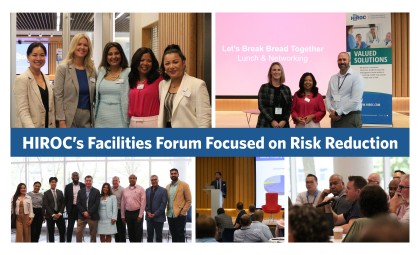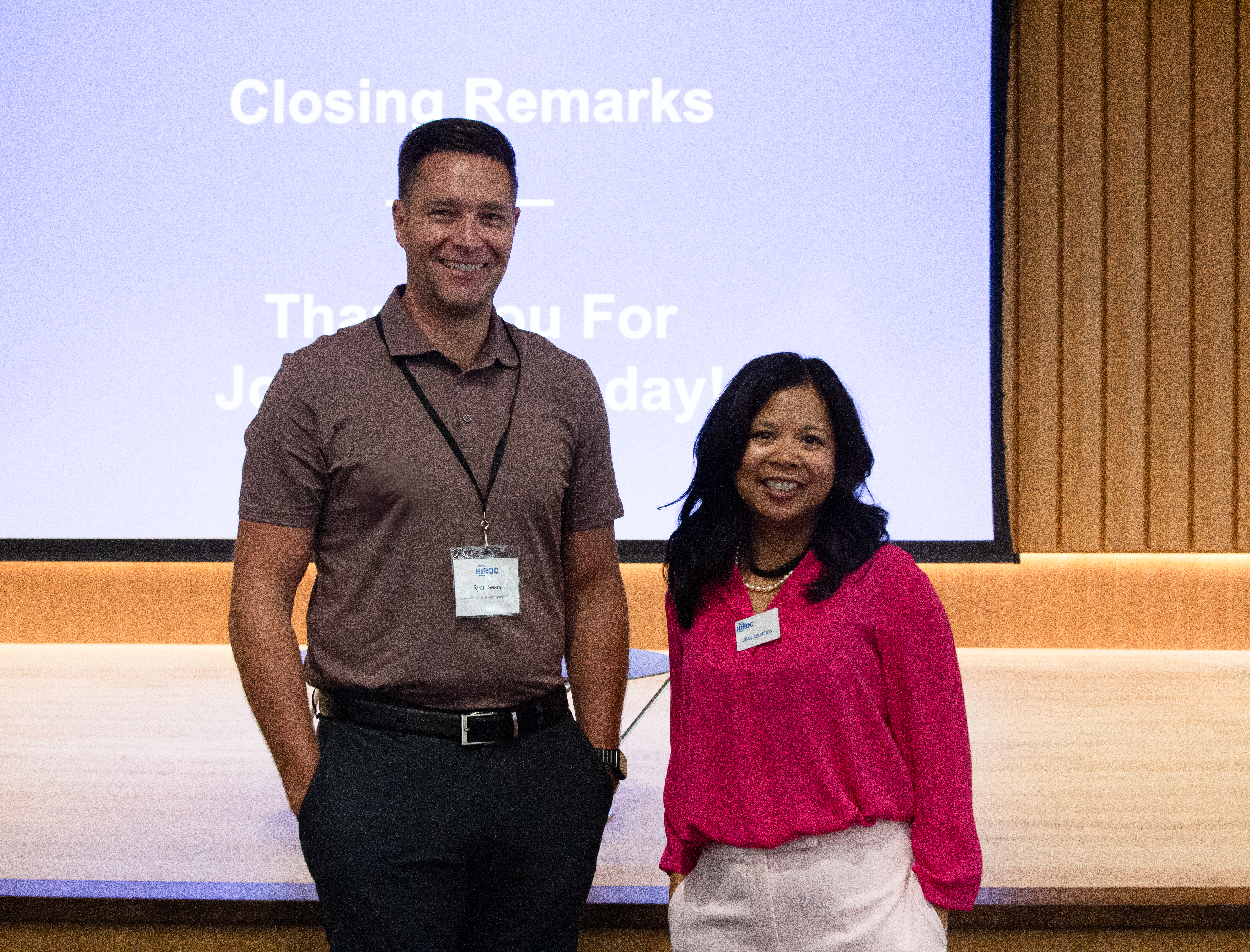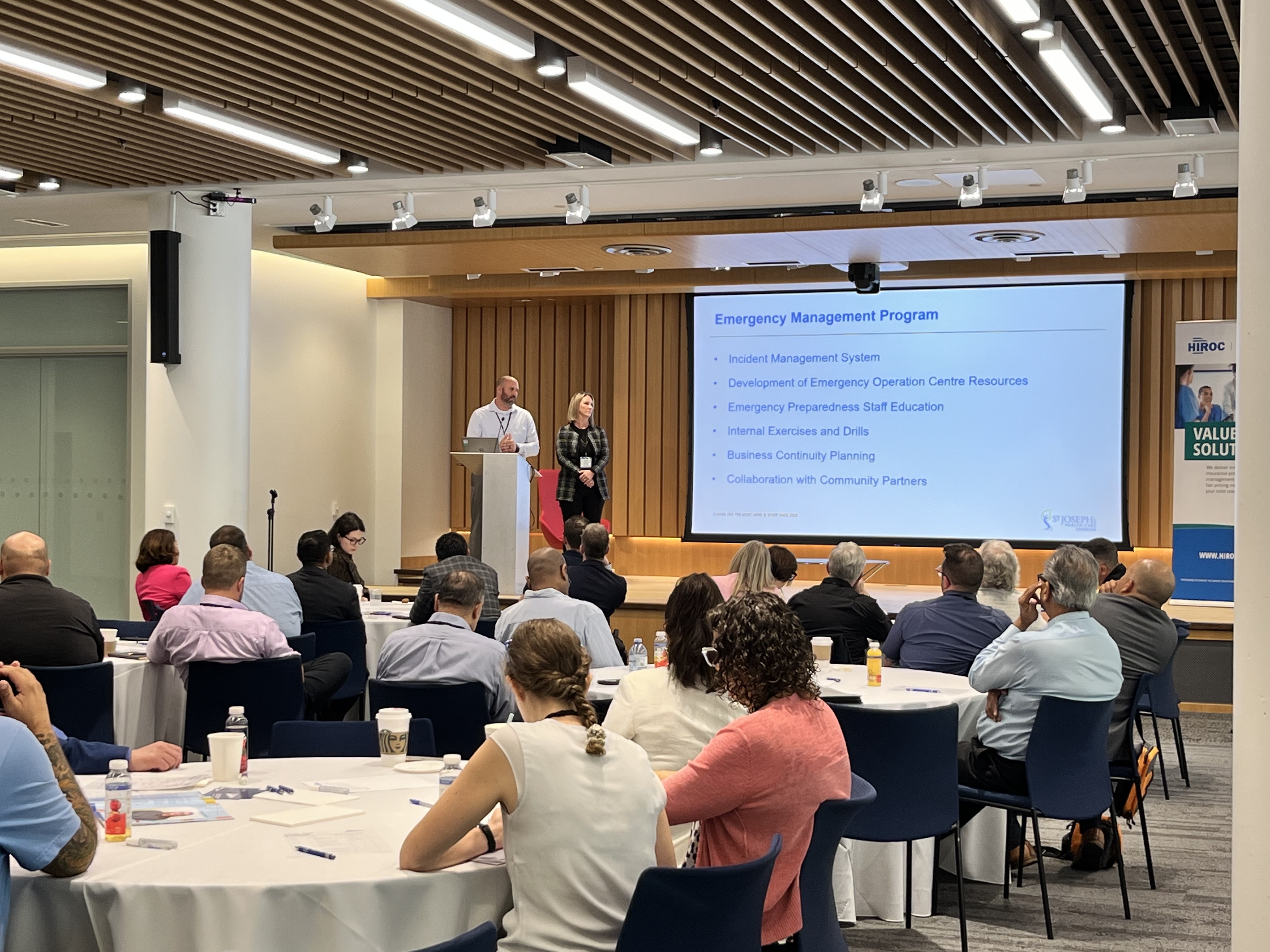HIROC’s Facilities Forum Focused on Risk Reduction

At HIROC, knowledge sharing is at the heart of what we do. That includes sharing tools and resources and hosting learning opportunities for our Subscribers to improve safety in the healthcare system.
HIROC recently hosted our annual Facilities Forum where we got to hear stories from our Subscribers, stories aimed at mitigating facility risks and sharing countless lessons learned, all with the goal of scaling the valuable knowledge of our community. “It really takes a village to help each other and continue providing healthcare services to our communities,” HIROC’s Jean Asuncion, Senior Account Executive, said.

Learnings From Our Subscribers
The team from Michael Garron Hospital (MGH) shared their story of how they sprang into action once they detected a gas leak. MGH initiated their emergency command post and Code Orange to manage the situation, and it was safely resolved later that day. Schubert Martin, Director, Engineering Services, shared MGH’s learnings from this incident:
- Using a single point of communication for internal teams (e.g. team leaders) who controlled the flow of information internally and externally kept everyone informed and reduced panic
- MGH also used clear, concise messaging and had staff walking around the building to answer questions
- Collaborating with MGH staff, Enbridge Gas, firefighters, police, and paramedics ensured there were no injuries
- Changing their process for future construction work to use hydro vacuum excavation when dealing with natural gas or high voltage infrastructure, instead of digging, will reduce the risk of a similar incident reoccurring
- Having the flexibility to isolate certain areas with separate buildings or wings helped keep everyone safe
St. Joseph’s Health Care London shared the importance of emergency preparedness exercises, walking delegates through a few of their most recent simulations. Danica Low, Manager, Patient Relations, Privacy and Risk; and Peter Kreis, Manager, Security Services, Mailroom and Transportation Services, covered why it’s critical to have an Emergency Management Program and what it should include.
An Emergency Management Program should consist of
- An Incident Management System for emergency response
- Development of Emergency Operation Centre resources
- Includes a physical command centre with printers, paper, pens, phones, etc. and different location options depending on the emergency
- Staff education on emergency preparedness
- Covers how to identify and respond to emergencies; start with leadership and communications department and then the rest of the organization
- Internal drills and exercises
- Includes fire drills and code trainings
- Business continuity planning
- Plans for each department listing key individuals who need to be notified and how departments should respond that are reviewed annually
- Collaboration with community partners
- Includes city, infrastructure, first responders, etc. and everyone has a say in planning and exercises (e.g. tabletop exercises)

Tools to Mitigate Facility Risks
HIROC’s insurance partners at FM and HSB Canada shared some useful tools and services exclusively available to Subscribers to help mitigate risks in various situations, including managing contractors, responding to water leakage emergencies, reviewing building plans, and managing transformer equipment breakdowns.
Ryan Doggart, Manager, Training & Engineering Quality at FM, provided an overview of the newly updated Contractor Management Manual, made in collaboration with HIROC. This manual provides property loss prevention guidelines that contractors should follow. Main topics include site access and security, ignition source control, fire protection and impairment management, housekeeping, and hazardous materials and processes.
“Water damage is the loss driver in frequency and severity,” HIROC’s Jean Asuncion noted, and Doggart also highlighted liquid damage guidelines and water leakage emergency response planning. The Liquid Damage Guidelines include considering construction and location. Critical rooms like the MRI rooms and server rooms should be above-grade and out of flood plains, and they should not be under areas prone to leaks (e.g. washers, cafeterias, mechanical rooms). Steam, water, and drain lines should be routed around critical rooms.
Organizations should also have a Water Leakage Emergency Response Plan that includes
- Scope, response team, contact information, and who has authority to make decisions
- Leak procedure
- List of applicable contractors and vendors
- Stocked spill carts
- Lists or drawings of isolation valves
- Time to review plan and provide regular training
- Maintenance on valves and systems to ensure functionality
Ivan Rodriguez, Group Manager, Account Engineering at FM, spoke about FM’s Plan Review Service to review building plans for new construction, expansions, site projects, equipment installation, and more. This service also includes analyzing plans for site selection, land acquisition, building additions, process and equipment changes, risk improvement, and fire sprinkler systems. If you’d like more information about this service, please contact Jean Asuncion at [email protected].
Finally, Greg Good, Claims Supervisor at HSB Canada, covered equipment breakdown claims focusing on transformers. He noted it’s important not to forget about transformers as they are in every facility to transform outside transmission line volts into usable volts. There are three main types of transformers: single phase or three phase systems, dry type or oil-filled, and step-down or step-up. Different transformer types can lead to different types of claims and hazards to look out for. Claims related to transformers can include property damage, extra expense or business interruption, and spoilage if a power outage causes spoiled products like pharmaceuticals.
In the event of a transformer claim, follow these steps:
- Contact HIROC as soon as possible
- Compile information and document everything (photos, record statements, quotes, etc.) and give it to insurers
- If temporary measures are needed, get quotes and options for rental and new equipment
- Allow insurers to inspect the unit before it’s moved to help decide whether to repair or replace it

More Resources
One of the many ways HIROC has been keeping property matters top of mind for our Subscribers recently is through our exclusive LinkedIn Live series, Facility Focus. This series highlights innovative projects and solutions our healthcare community is actioning to build a more resilient healthcare system for patients, staff and the communities they serve.
You can watch the latest episode now featuring Reena Engman from Covenant Health Canada. In this episode, Reena discusses their groundbreaking Covenant Wellness Community project and the ways her organization is addressing property risks like climate change and aging infrastructure.
Here are a few more tools and resources to help your team:
- HIROC and FM’s Property Loss Prevention Manual covers topics including water leakage emergency response plans and sprinkler system impairment management
- FM’s Approval Guide has information on how to plan construction projects and FM-approved equipment tested for reliability
- FM’s property loss data sheets are guidelines for different types of construction, materials, and more based on FM’s own research and loss data
HIROC’s 2024 Facilities Forum fostered learning and connection with the goal of turning the corner on patient safety. Leaving Subscribers something to think about, Jonathan Bracamonte, HIROC’s Director, Brokerage Services, and his team, made sure to emphasize the importance of human element control programs – programs that are generally not capital intensive and can significantly reduce the frequency and severity of property claims. “We look forward to collaborating to improve safety and build resiliency in your facilities,” Jonathan Bracamonte, HIROC’s Director, Brokerage Services, emphasized. Thank you for joining us and making the forum a success, and we look forward to seeing you again next year!
By Gillian Brandon-Hart, Communications and Marketing Specialist, HIROC